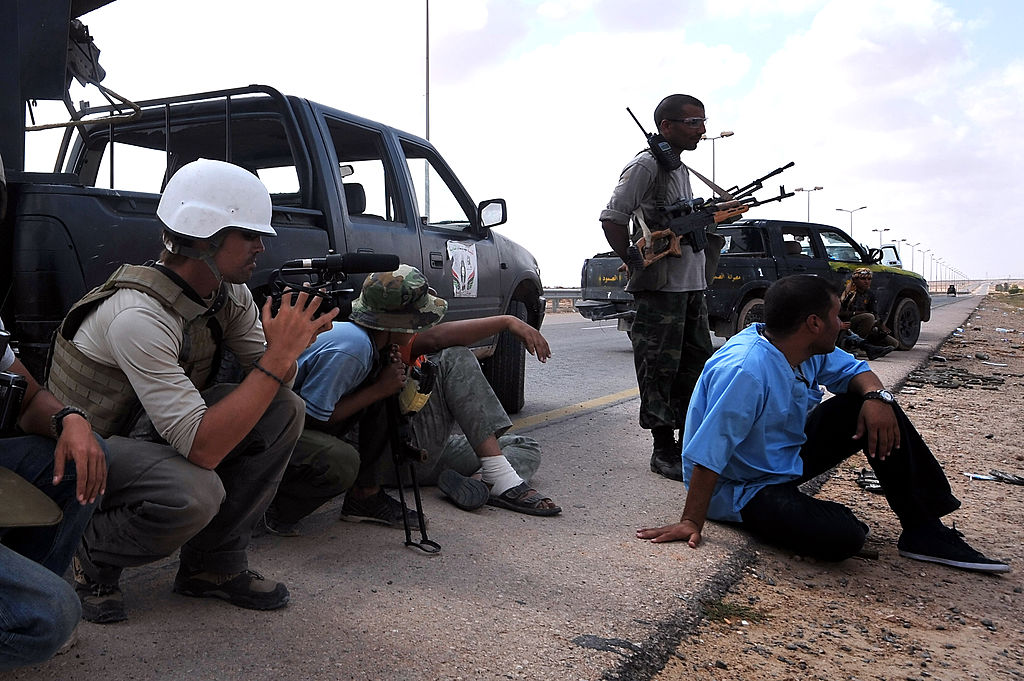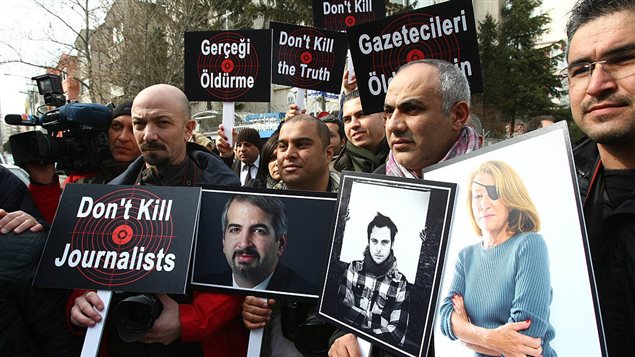The number of journalists killed in the line of duty is on track to decline by a third in 2016 compared to the previous year, as fewer journalists were targeted for murder, according to the annual analysis of journalist fatalities released today by the Committee to Protect Journalists.
“One thing that stood out this year was that a lot of journalists died covering combat and conflict,” said Elana Beiser, editorial director of the Committee to Protect Journalists and one of the authors of the report. “The most dangerous beat was war.”
(click to listen to the full interview with Elana Beiser)
ListenDeadly beat
In fact, more than half of the 48 journalists who were killed in 2016 so far have died in the act of covering combat or conflict, she said.
That’s an aberration from a trend the CPJ has seen ever since the press freedom NGO began tracking the number of deaths of journalists in 1992.
Historically about two-thirds of journalists killed in the line of duty were murdered in direct retaliation for their reporting, Beiser said.
“But this year that proportion was significantly lower and instead we saw many killed in combat,” she said.
Breakdown: Journalists Killed in 2016 from Committee to Protect Journalists on Vimeo. (Courtesy of CPJ)
While safety training and equipment for journalists assigned to cover conflicts has taken on a new prominence in large Western news organizations, it’s a different story for local journalists and freelancers who do most of the dangerous legwork in conflict zones.
Increasingly, either because of safety concerns for Western journalists or difficulty of access, the most dangerous jobs of combat reporting fall to local journalists or freelancers who often do not have the required resources or training, Beiser said. Nine out of ten journalists killed while covering conflicts in 2016 were local reporters, she said.
Syria, Iraq and Yemen the most dangerous places for journalists
Syria remains the most dangerous place for journalists with 14 reporters killed so far.
“It has been the most deadly place for journalists for five years now,” Beiser said.
Iraq and Yemen, with six journalists killed in each, hold the second and third places as the most dangerous countries in the world.
Journalists who cover conflict risk not only of being killed in combat but also of being kidnapped or murdered by Islamic State and other militant groups, the CPJ report said.
Islamic State is responsible for the disappearance of at least 11 journalists since 2013, according to CPJ. They are feared dead, but do not appear in CPJ’s data on killed journalists because their fate cannot be confirmed, the report said.
In fact, the ravaging of journalistic communities by extremist groups in recent years could be one of several potential reasons for the decline in murders in 2016, the report said.

A photo taken on September 29, 2011 shows US freelance reporter James Foley (L) on the highway between the airport and the West Gate of Sirte, Libya. Foley was kidnapped and executed by ISIS in 2013. ARIS MESSINIS/AFP/Getty Images)
“For example, in Somalia, the killers’ work has had an effect: Years of violent intimidation with little hope of justice has left the ranks of the media scared, weakened, and depleted,” the report said.
Civilians, not combatants
The CPJ in the meantime is trying to drive home a simple message that journalists are civilians and as such are protected under international law, Beiser said.
“They are not combatants, they are civilians and they should be protected under international law,” she said.
The group is also part of a new alliance of press freedom and major news organizations called ACOS Alliance that stands for A Culture of Safety.
“Basically we’re advocating, particularly for media organizations that rely heavily on freelancers to give them as much support as possible in the field and to encourage freelancers to prepare properly for covering conflict,” Beiser said.







For reasons beyond our control, and for an undetermined period of time, our comment section is now closed. However, our social networks remain open to your contributions.